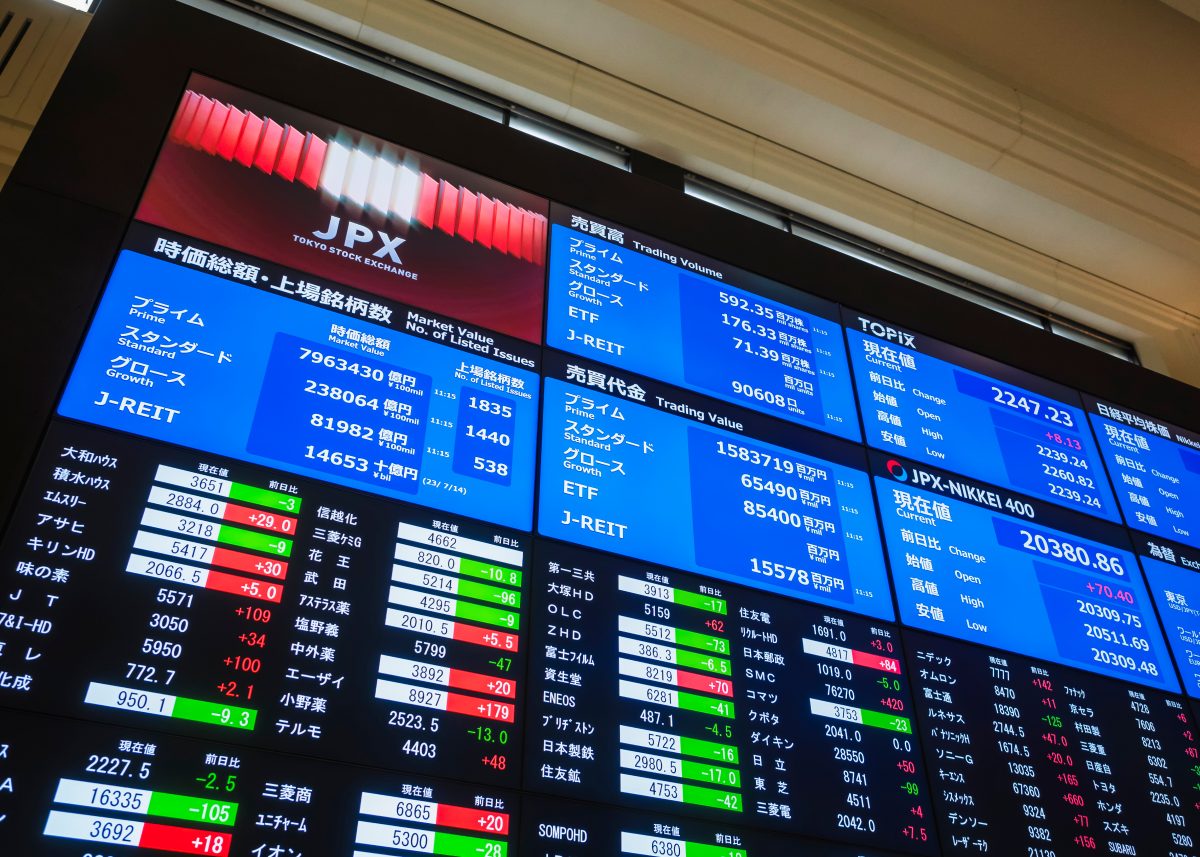IC Markets Europe Fundamental Forecast | 22 April 2025
What happened in the Asia session?
The Core CPI, as tracked by the Bank of Japan (BoJ), accelerated from an annual rate of 1.5% in October to 2.2% in January and February due to a persistent increase in food prices. The core reading rose 2.2% once again in March, undershooting the forecast of 2.4% increase. With price pressures abating for the second consecutive month, demand for the yen tapered off slightly, with USD/JPY climbing above 140 after dipping to a low of 139.91 during this session.
What does it mean for the Europe & US sessions?
ECP President Christine Lagarde will be interviewed by CNBC later today where she could provide further insights into the ongoing tariff negotiations between the U.S. and the European Union, as well as deliver the latest status on its progress, if any. In addition, she could also shed further light on how the current global macroeconomic environment had influenced this central bank’s decision-making process at last week’s monetary policy meeting. The Euro jumped 1.5% at its highest point on Monday before taking a breather – this currency pair was hovering around 1.1500 by midday in Asia.
The Dollar Index (DXY)
Key news events today
Richmond Manufacturing Index (2:00 pm GMT)
What can we expect from DXY today?
After improving in the previous month, the Richmond manufacturing index slowed in March as it fell to -4, missing market expectations for a second successive month of higher output. The estimate for April points to a second consecutive month of decline but at a faster rate, a result that is influenced heavily by the ongoing tariff escalation and uncertainty between the U.S. and its major trading partners, placing further pressure on the dollar.
Central Bank Notes:
- The Board of Governors of the Federal Reserve System voted unanimously to maintain the Federal Funds Rate in a target range of 4.25 to 4.50% on 19 March 2025
- The Committee seeks to achieve maximum employment and inflation at the rate of 2% over the longer run but uncertainty around the economic outlook has increased; the Committee is attentive to the risks to both sides of its dual mandate.
- Recent indicators suggest that economic activity has continued to expand at a solid pace while the unemployment rate has stabilized at a low level in recent months, and labour market conditions remain solid. However, inflation remains somewhat elevated.
- GDP growth forecasts were revised downward for 2025 (1.7% vs. 2.1% in the December projection) while PCE inflation projections have been adjusted slightly higher for 2025, with core inflation expected to reach 2.5%, partly due to tariff-related pressures.
- In assessing the appropriate stance of monetary policy, the Committee will continue to monitor the implications of incoming information for the economic outlook and is prepared to adjust the stance of monetary policy as appropriate if risks emerge that could impede the attainment of its goals.
- Beginning in April, the Committee will slow the pace of decline of its securities holdings by reducing the monthly redemption cap on Treasury securities from $25B to $5B while maintaining the monthly redemption cap on agency debt and agency mortgage-backed securities at $35B.
- The next meeting is scheduled for 6 to 7 May 2025.
Next 24 Hours Bias
Medium Bearish
Gold (XAU)
Key news events today
Richmond Manufacturing Index (2:00 pm GMT)
What can we expect from Gold today?
After improving in the previous month, the Richmond manufacturing index slowed in March as it fell to -4, missing market expectations for a second successive month of higher output. The estimate for April points to a second consecutive month of decline but at a faster rate, a result that is influenced heavily by the ongoing tariff escalation and uncertainty between the U.S. and its major trading partners, placing further pressure on the dollar which would provide additional tailwinds for gold prices.
Next 24 Hours Bias
Medium Bullish
The Australian Dollar (AUD)
Key news events today
No major news events.
What can we expect from AUD today?
Australian markets resumed trading on Tuesday following a four-day closure due to the Easter holidays. The Aussie hit an overnight high of 0.6437 before pulling back slightly as Asian markets came online on Tuesday – this currency pair should remain elevated above 0.6400 as the day progresses.
Central Bank Notes:
- The RBA maintained the cash rate at 4.10% on 1 April, following a 25-basis point reduction on 18 February.
- Inflation has fallen substantially since the peak in 2022, as higher interest rates have been working to bring aggregate demand and supply closer towards balance.
- Recent information suggests that underlying inflation continues to ease in line with the most recent forecasts published in the February Statement on Monetary Policy.
- Private domestic demand appears to be recovering, real household incomes have picked up and there has been an easing in some measures of financial stress. However, businesses in some sectors continue to report that weakness in demand makes it difficult to pass on cost increases to final prices.
- At the same time, a range of indicators suggest that labour market conditions remain tight. Despite a decline in employment in February, measures of labour underutilisation are at relatively low rates and business surveys and liaison suggest that availability of labour is still a constraint for a range of employers. Wage pressures have eased a little more than expected but productivity growth has not picked up and growth in unit labour costs remains high.
- There are notable uncertainties about the outlook for domestic economic activity and inflation. The central projection is for growth in household consumption to continue to increase as income growth rises. But there is a risk that any pick-up in consumption is slower than expected, resulting in continued subdued output growth and a sharper deterioration in the labour market than currently expected.
- Uncertainty about the outlook abroad also remains significant. On the macroeconomic policy front, recent announcements from the U.S. on tariffs are having an impact on confidence globally and this would likely be amplified if the scope of tariffs widens, or other countries take retaliatory measures. Geopolitical uncertainties are also pronounced.
- The Board’s assessment is that monetary policy remains restrictive and the continued decline in underlying inflation is welcome, but there are nevertheless risks on both sides and the Board is cautious about the outlook.
- The Board will rely upon the data and the evolving assessment of risks to guide its decisions and is resolute in its determination to sustainably return inflation to target and will do what is necessary to achieve that outcome.
- The next meeting is on 20 May 2025.
Next 24 Hours Bias
Medium Bullish
The Kiwi Dollar (NZD)
Key news events today
No major news events.
What can we expect from NZD today?
Following a four-day closure due to the Easter holidays, the Kiwi rallied more than 1.5% to make an overnight high of 0.6019. Despite fizzling out at the beginning of Tuesday’s session as it dipped under the threshold of 0.6000, this currency pair will likely remain elevated.
Central Bank Notes:
- The Monetary Policy Committee (MPC) agreed to reduce the Official Cash Rate (OCR) by 25 basis points bringing it down to 3.50% on 9 April, marking the fifth consecutive rate cut.
- The Committee assessed that annual consumer price inflation remains near the midpoint of the MPC’s 1 to 3% target band while firms’ inflation expectations and core inflation are consistent with inflation remaining at target over the medium term.
- Economic activity has evolved largely as expected since the February Monetary Policy Statement; higher-than-expected export prices and a lower exchange rate have supported primary sector incomes and overall economic growth.
- Although monetary restraint had been removed at pace, household spending and residential investment have remained weak.
- The recently announced increases in global trade barriers weaken the outlook for global economic activity. On balance, these developments create downside risks to the outlook for economic activity and inflation.
- The Committee noted that the increase in tariffs will take time to work through the global economy, but the direct price increases for economies imposing tariffs and the dampening impact of increased economic uncertainty on global demand will occur relatively quickly.
- With CPI inflation close to the mid-point of the target range, significant spare capacity in the economy, and a weaker activity outlook stemming from global trade policy, the Committee agreed that a further reduction in the OCR was appropriate.
- Meanwhile, future policy decisions will be determined by the outlook for inflationary pressure over the medium term.
- The next meeting is on 28 May 2025.
Next 24 Hours Bias
Medium Bullish
The Japanese Yen (JPY)
Key news events today
BoJ Core CPI (5:00 am GMT)
What can we expect from JPY today?
The Core CPI, as tracked by the Bank of Japan (BoJ), accelerated from an annual rate of 1.5% in October to 2.2% in January and February due to a persistent increase in food prices. The core reading rose 2.2% once again in March, undershooting the forecast of 2.4% increase. With price pressures abating for the second consecutive month, demand for the yen tapered off slightly, with USD/JPY climbing above 140 after dipping to a low of 139.91 during this session.
Central Bank Notes:
- The Policy Board of the Bank of Japan decided on 19 March, by a unanimous vote, to maintain the following guidelines for money market operations for the inter-meeting period:
- The Bank will encourage the uncollateralized overnight call rate to remain at around 0.5%.
- The Bank will continue its plan to reduce the amount of its monthly outright purchases of JGBs, aiming to reach about 3 trillion yen by January-March 2026.
- Japan’s economy has continued to recover moderately, with some sectors showing improvement. Exports and industrial production have remained relatively stable, while corporate profits continue on an improving trend and business sentiment maintains a favourable level.
- The employment and income situation has shown moderate improvement, with private consumption on a moderately increasing trend despite ongoing impacts from price rises.
- On the price front, the year-on-year rate of increase in the consumer price index (CPI, all items less fresh food) has been in the range of 3.0-3.5% recently. Services prices continue to rise moderately, reflecting factors such as wage increases, while the effects of cost pass-through from past import price rises have diminished.
- Inflation expectations have continued to rise moderately, with underlying CPI inflation gradually increasing toward the price stability target of 2%. The virtuous cycle between wages and prices continues to strengthen, with businesses increasingly reflecting higher costs in selling prices.
- Japan’s economy is expected to maintain growth above its potential rate, supported by moderately growing overseas economies and the intensifying virtuous cycle from income to spending, underpinned by accommodative financial conditions.
- The next meeting is scheduled for 1 May 2025.
Next 24 Hours Bias
Medium Bearish
The Euro (EUR)
Key news events today
ECB President Lagarde’s Speech (2:00 pm GMT)
What can we expect from EUR today?
ECP President Christine Lagarde will be interviewed by CNBC later today where she could provide further insights into the ongoing tariff negotiations between the U.S. and the European Union, as well as deliver the latest status on its progress, if any. In addition, she could also shed further light on how the current global macroeconomic environment had influenced this central bank’s decision-making process at last week’s monetary policy meeting. The Euro jumped 1.5% at its highest point on Monday before taking a breather – this currency pair was hovering around 1.1490 as Asian markets came online on Tuesday.
Central Bank Notes:
- The Governing Council reduced the three key ECB interest rates by 25 basis points on 17 April to mark the sixth successive rate cut.
- Accordingly, the interest rate on the main refinancing operations and the interest rates on the marginal lending facility and the deposit facility will be decreased to 2.40%, 2.65% and 2.25% respectively.
- The disinflation process is well on track with both headline and core inflation declining in March while services inflation has also eased markedly over recent months. Most measures of underlying inflation suggest that inflation will settle at around the Governing Council’s 2% medium-term target on a sustained basis.
- Wage growth is moderating, and profits are partially buffering the impact of still elevated wage growth on inflation. The euro area economy has been building up some resilience against global shocks, but the outlook for growth has deteriorated owing to rising trade tensions.
- Increased uncertainty is likely to reduce confidence among households and firms, and the adverse and volatile market response to the trade tensions is likely to have a tightening impact on financing conditions. These factors may further weigh on the economic outlook for the euro area.
- The asset purchase programme (APP) and pandemic emergency purchase programme (PEPP) portfolios are declining at a measured and predictable pace, as the Eurosystem no longer reinvests the principal payments from maturing securities.
- The Governing Council is determined to ensure that inflation stabilises sustainably at its 2% medium-term target. Especially in current conditions of exceptional uncertainty, it will follow a data-dependent and meeting-by-meeting approach to determining the appropriate monetary policy stance.
- In particular, the Council’s interest rate decisions will be based on its assessment of the inflation outlook in light of the incoming economic and financial data, the dynamics of underlying inflation and the strength of monetary policy transmission.
- The next meeting is on 5 June 2025.
Next 24 Hours Bias
Medium Bullish
The Swiss Franc (CHF)
Key news events today
No major news events.
What can we expect from CHF today?
Demand for safe-haven assets such as the franc remained elevated as USD/CHF fell nearly 1.2% on Monday. This currency pair tumbled as low as 0.8039 before recovering to find its footing around 0.8100 at the beginning of Tuesday’s session.
Central Bank Notes:
- The SNB eased monetary policy by lowering its key policy rate by 25 basis points, from 0.50% to 0.25% on 20 March 2025, marking the fifth consecutive reduction.
- Underlying inflationary pressure has decreased further this quarter.
- Inflation in the period since the last monetary policy assessment has again been lower than expected, decreasing from 0.7% in November to 0.3% in February, primarily due to lower electricity prices.
- In the shorter term, the new conditional inflation forecast is slightly higher than December: 0.3% for Q2 2025, 0.4% for 2025 overall, and 0.8% for 2026 and 2027, based on the assumption that the SNB policy rate remains at 0.25% over the entire forecast horizon.
- GDP growth in Switzerland remains moderate, with the services sector continuing to show slightly stronger growth, while manufacturing faces challenges.
- The SNB anticipates GDP growth of around 1.0% to 1.5% for 2025.
- The SNB will continue to monitor the situation closely and will adjust its monetary policy if necessary to ensure inflation remains within the range consistent with price stability over the medium term.
- The next meeting is on 19 June 2025.
Next 24 Hours Bias
Medium Bearish
The Pound (GBP)
Key news events today
No major news events.
What can we expect from GBP today?
Following a four-day closure due to the Easter holidays, British markets will resume trading today. Demand for Cable remained robust as it jumped 1% to make an overnight high of 1.3422 before running out of steam. This currency pair dipped under 1.3400 at the beginning of Tuesday’s session but it is likely to remain elevated.
Central Bank Notes:
- The Bank of England’s Monetary Policy Committee (MPC) voted by a majority of 8 to 1 to maintain the Bank Rate at 4.50% on 19 March 2025, while one member preferred to reduce it by 25 basis points (bps).
- The MPC also voted unanimously to reduce the stock of UK government bond purchases held for monetary policy purposes and financed by the issuance of central bank reserves, by £100B over the next 12 months to a total of £558B, starting in October 2024. On 18 December 2024, the stock of UK government bonds held for monetary policy purposes was £655B.
- Twelve-month CPI inflation increased to 3.0% in January from 2.5% in December, slightly higher than expected in the February Report; domestic price and wage pressures are moderating, but remain somewhat elevated.
- Although global energy prices have fallen back recently, they remain higher than last year and CPI inflation is still projected to rise to around 3.75% in 2025 Q3. While CPI inflation is expected to fall back thereafter, the Committee will pay close attention to any consequent signs of more lasting inflationary pressures.
- While UK GDP growth estimates have been slightly stronger than expected at the time of the February Monetary Policy Report, business survey indicators generally continue to suggest weakness in growth and particularly in employment intentions. In recent quarters, subdued activity has been judged to reflect both demand and supply factors.
- The labour market had continued to ease, although it was still judged to be broadly in balance – some indicators of employment intentions had deteriorated markedly, to levels consistent with shrinking employment while other indicators, such as the number of vacancies, had not weakened to the same extent.
- Domestic price and wage pressures were moderating, but remained somewhat elevated. A range of indicators suggested that underlying pay growth had eased further in recent months, although annual growth in private sector regular average weekly earnings had picked up to 6.1% in the three months to January.
- Based on the Committee’s evolving view of the medium-term outlook for inflation, a gradual and careful approach to the further withdrawal of monetary policy restraint is appropriate and it will continue to monitor closely the risks of inflation persistence and what the evolving evidence may reveal about the balance between aggregate supply and demand in the economy.
- Monetary policy will need to continue to remain restrictive for sufficiently long until the risks to inflation returning sustainably to the 2% target in the medium term have dissipated further and the Committee will decide the appropriate degree of monetary policy restrictiveness at each meeting.
- The next meeting is on 8 May 2025.
Next 24 Hours Bias
Medium Bullish
The Canadian Dollar (CAD)
Key news events today
No major news events.
What can we expect from CAD today?
Continued sell-off in the greenback drove USD/CAD under 1.3800 overnight. This currency pair stabilized in the early hours of Tuesday to float around 1.3830 but overhead pressures remain firmly intact.
Central Bank Notes:
- The Bank of Canada today maintained its target for the overnight rate at 2.75%, with the Bank Rate at 3% and the deposit rate at 2.70% – marking the first pause after seven consecutive meetings where rates were reduced.
- The major shift in direction of U.S. trade policy and the unpredictability of tariffs have increased uncertainty, diminished prospects for economic growth, and raised inflation expectations.
- Pervasive uncertainty makes it unusually challenging to project GDP growth and inflation in Canada and globally – the April Monetary Policy Report (MPR) presents two scenarios that explore different paths for US trade policy.
- In the first scenario, uncertainty is high but tariffs are limited in scope – Canadian growth weakens temporarily and inflation remains around the 2% target. In the second scenario, a protracted trade war causes Canada’s economy to fall into recession this year and inflation rises temporarily above 3% next year.
- Global economic growth was solid in late 2024 and inflation has been easing towards central bank targets. However, tariffs and uncertainty have weakened the outlook. In the U.S., the economy is showing signs of slowing amid rising policy uncertainty and rapidly deteriorating sentiment, while inflation expectations have risen. In the Euro Area, growth has been modest in early 2025, with continued weakness in the manufacturing sector. China’s economy was strong at the end of 2024 but more recent data shows it slowing modestly.
- In Canada, the economy is slowing as tariff announcements and uncertainty pull down consumer and business confidence. Consumption, residential investment and business spending all look to have weakened in the first quarter. Trade tensions are also disrupting recovery in the labour market. Employment declined in March and businesses are reporting plans to slow their hiring. Wage growth continues to show signs of moderation.
- The Governing Council will continue to assess the timing and strength of both the downward pressures on inflation from a weaker economy and the upward pressures on inflation from higher costs while proceeding carefully, with particular attention to the risks and uncertainties facing the Canadian economy.
- Monetary policy cannot resolve trade uncertainty or offset the impacts of a trade war and the Governing Council will focus on ensuring that Canadians continue to have confidence in price stability through this period of global upheaval by supporting economic growth while ensuring that inflation remains well-controlled.
- The next meeting is on 4 June 2025.
Next 24 Hours Bias
Medium Bearish
Oil
Key news events today
API Crude Oil Stock (8:30 pm GMT)
What can we expect from Oil today?
After falling 2.8% on Monday, crude oil prices climbed in early trade on Tuesday, most likely due to short-covering activity. However, concerns surrounding economic headwinds from tariffs and U.S. monetary policy persist, damping global fuel demand. WTI oil rose above $63 per barrel and could grind higher as the day progresses. Moving over to U.S. inventories, the API stockpiles have continued to build higher in 2025, signalling weaker demand for crude. Another strong rise in these inventory levels could cause prices to stall later today.
Next 24 Hours Bias
Medium Bearish




